transmission GMC YUKON 2009 Repair Manual
[x] Cancel search | Manufacturer: GMC, Model Year: 2009, Model line: YUKON, Model: GMC YUKON 2009Pages: 576, PDF Size: 3.06 MB
Page 533 of 576
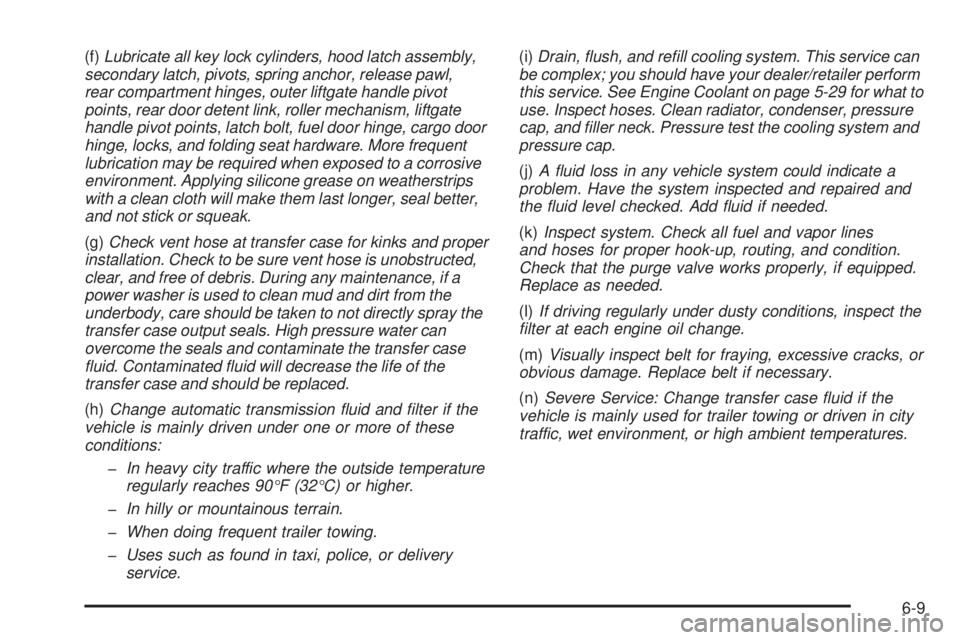
(f)Lubricate all key lock cylinders, hood latch assembly,
secondary latch, pivots, spring anchor, release pawl,
rear compartment hinges, outer liftgate handle pivot
points, rear door detent link, roller mechanism, liftgate
handle pivot points, latch bolt, fuel door hinge, cargo door
hinge, locks, and folding seat hardware. More frequent
lubrication may be required when exposed to a corrosive
environment. Applying silicone grease on weatherstrips
with a clean cloth will make them last longer, seal better,
and not stick or squeak.
(g)Check vent hose at transfer case for kinks and proper
installation. Check to be sure vent hose is unobstructed,
clear, and free of debris. During any maintenance, if a
power washer is used to clean mud and dirt from the
underbody, care should be taken to not directly spray the
transfer case output seals. High pressure water can
overcome the seals and contaminate the transfer case
fluid. Contaminated fluid will decrease the life of the
transfer case and should be replaced.
(h)Change automatic transmission fluid and filter if the
vehicle is mainly driven under one or more of these
conditions:
�In heavy city traffic where the outside temperature
regularly reaches 90°F (32°C) or higher.
�In hilly or mountainous terrain.
�When doing frequent trailer towing.
�Uses such as found in taxi, police, or delivery
service.(i)Drain, flush, and refill cooling system. This service can
be complex; you should have your dealer/retailer perform
this service. See Engine Coolant on page 5-29 for what to
use. Inspect hoses. Clean radiator, condenser, pressure
cap, and filler neck. Pressure test the cooling system and
pressure cap.
(j)A fluid loss in any vehicle system could indicate a
problem. Have the system inspected and repaired and
the fluid level checked. Add fluid if needed.
(k)Inspect system. Check all fuel and vapor lines
and hoses for proper hook-up, routing, and condition.
Check that the purge valve works properly, if equipped.
Replace as needed.
(l)If driving regularly under dusty conditions, inspect the
filter at each engine oil change.
(m)Visually inspect belt for fraying, excessive cracks, or
obvious damage. Replace belt if necessary.
(n)Severe Service: Change transfer case fluid if the
vehicle is mainly used for trailer towing or driven in city
traffic, wet environment, or high ambient temperatures.
6-9
Page 535 of 576
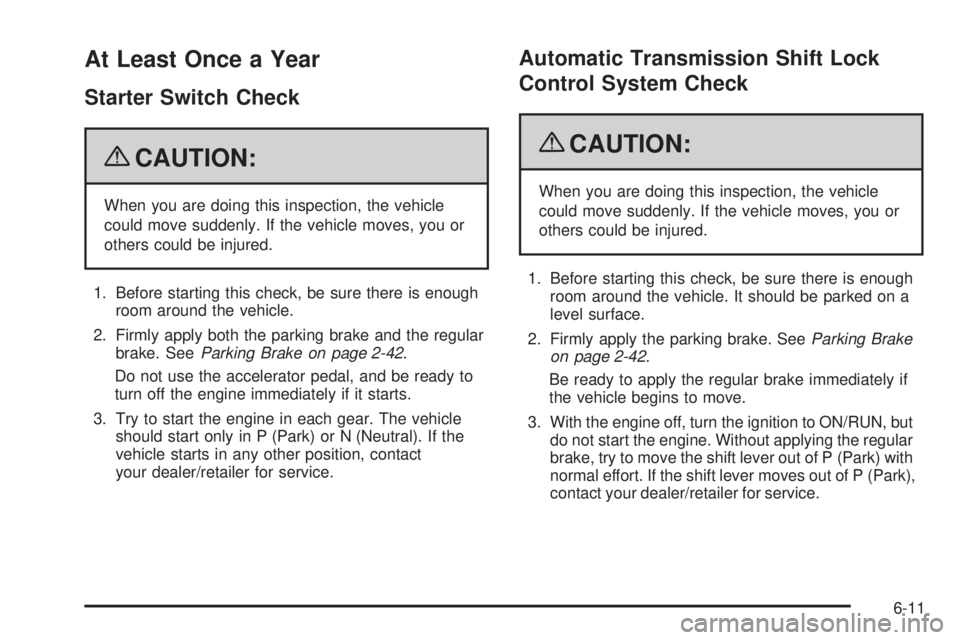
At Least Once a Year
Starter Switch Check
{CAUTION:
When you are doing this inspection, the vehicle
could move suddenly. If the vehicle moves, you or
others could be injured.
1. Before starting this check, be sure there is enough
room around the vehicle.
2. Firmly apply both the parking brake and the regular
brake. SeeParking Brake on page 2-42.
Do not use the accelerator pedal, and be ready to
turn off the engine immediately if it starts.
3. Try to start the engine in each gear. The vehicle
should start only in P (Park) or N (Neutral). If the
vehicle starts in any other position, contact
your dealer/retailer for service.
Automatic Transmission Shift Lock
Control System Check
{CAUTION:
When you are doing this inspection, the vehicle
could move suddenly. If the vehicle moves, you or
others could be injured.
1. Before starting this check, be sure there is enough
room around the vehicle. It should be parked on a
level surface.
2. Firmly apply the parking brake. SeeParking Brake
on page 2-42.
Be ready to apply the regular brake immediately if
the vehicle begins to move.
3. With the engine off, turn the ignition to ON/RUN, but
do not start the engine. Without applying the regular
brake, try to move the shift lever out of P (Park) with
normal effort. If the shift lever moves out of P (Park),
contact your dealer/retailer for service.
6-11
Page 536 of 576
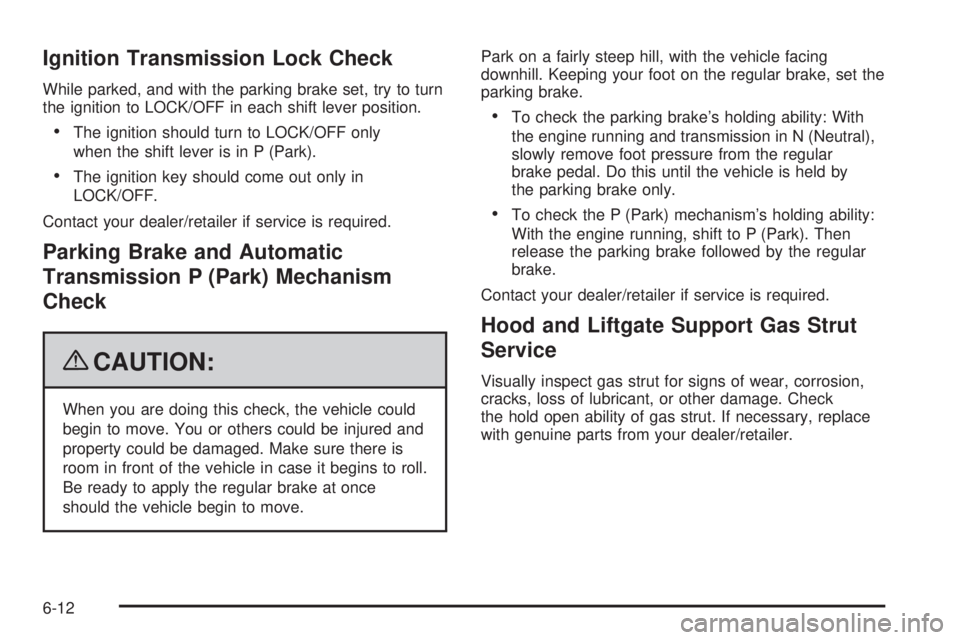
Ignition Transmission Lock Check
While parked, and with the parking brake set, try to turn
the ignition to LOCK/OFF in each shift lever position.
The ignition should turn to LOCK/OFF only
when the shift lever is in P (Park).
The ignition key should come out only in
LOCK/OFF.
Contact your dealer/retailer if service is required.
Parking Brake and Automatic
Transmission P (Park) Mechanism
Check
{CAUTION:
When you are doing this check, the vehicle could
begin to move. You or others could be injured and
property could be damaged. Make sure there is
room in front of the vehicle in case it begins to roll.
Be ready to apply the regular brake at once
should the vehicle begin to move.Park on a fairly steep hill, with the vehicle facing
downhill. Keeping your foot on the regular brake, set the
parking brake.
To check the parking brake’s holding ability: With
the engine running and transmission in N (Neutral),
slowly remove foot pressure from the regular
brake pedal. Do this until the vehicle is held by
the parking brake only.
To check the P (Park) mechanism’s holding ability:
With the engine running, shift to P (Park). Then
release the parking brake followed by the regular
brake.
Contact your dealer/retailer if service is required.
Hood and Liftgate Support Gas Strut
Service
Visually inspect gas strut for signs of wear, corrosion,
cracks, loss of lubricant, or other damage. Check
the hold open ability of gas strut. If necessary, replace
with genuine parts from your dealer/retailer.
6-12
Page 537 of 576
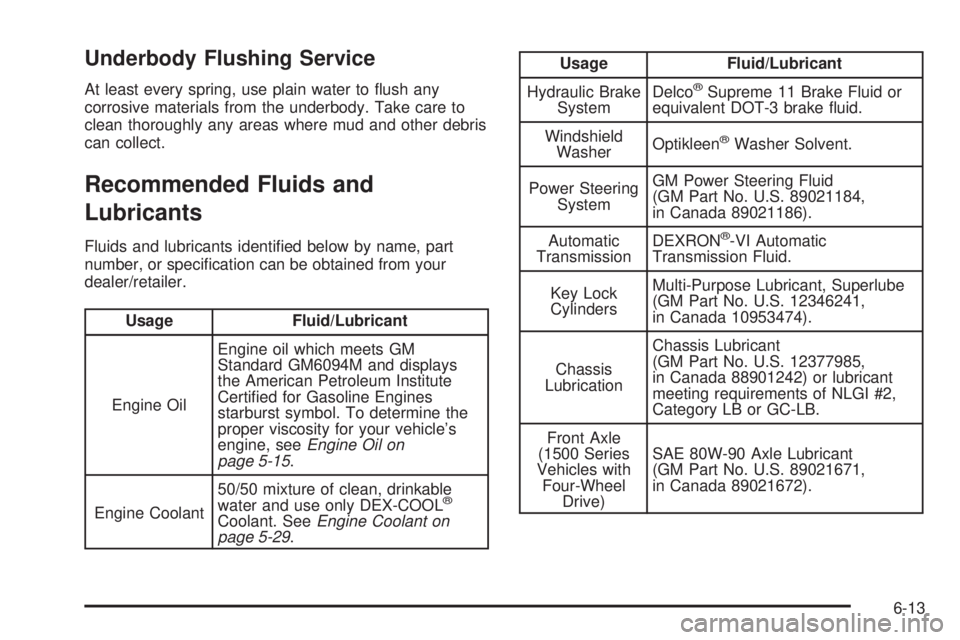
Underbody Flushing Service
At least every spring, use plain water to �ush any
corrosive materials from the underbody. Take care to
clean thoroughly any areas where mud and other debris
can collect.
Recommended Fluids and
Lubricants
Fluids and lubricants identi�ed below by name, part
number, or speci�cation can be obtained from your
dealer/retailer.
Usage Fluid/Lubricant
Engine OilEngine oil which meets GM
Standard GM6094M and displays
the American Petroleum Institute
Certi�ed for Gasoline Engines
starburst symbol. To determine the
proper viscosity for your vehicle’s
engine, seeEngine Oil on
page 5-15.
Engine Coolant50/50 mixture of clean, drinkable
water and use only DEX-COOL
®
Coolant. SeeEngine Coolant on
page 5-29.
Usage Fluid/Lubricant
Hydraulic Brake
SystemDelco
®Supreme 11 Brake Fluid or
equivalent DOT-3 brake �uid.
Windshield
WasherOptikleen
®Washer Solvent.
Power Steering
SystemGM Power Steering Fluid
(GM Part No. U.S. 89021184,
in Canada 89021186).
Automatic
TransmissionDEXRON
®-VI Automatic
Transmission Fluid.
Key Lock
CylindersMulti-Purpose Lubricant, Superlube
(GM Part No. U.S. 12346241,
in Canada 10953474).
Chassis
LubricationChassis Lubricant
(GM Part No. U.S. 12377985,
in Canada 88901242) or lubricant
meeting requirements of NLGI #2,
Category LB or GC-LB.
Front Axle
(1500 Series
Vehicles with
Four-Wheel
Drive)SAE 80W-90 Axle Lubricant
(GM Part No. U.S. 89021671,
in Canada 89021672).
6-13
Page 538 of 576
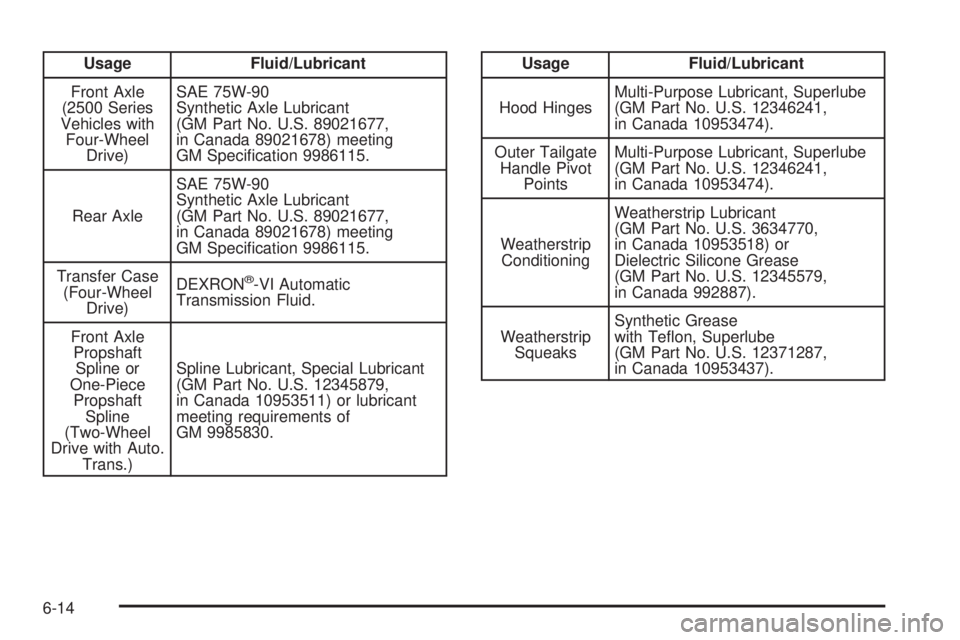
Usage Fluid/Lubricant
Front Axle
(2500 Series
Vehicles with
Four-Wheel
Drive)SAE 75W-90
Synthetic Axle Lubricant
(GM Part No. U.S. 89021677,
in Canada 89021678) meeting
GM Speci�cation 9986115.
Rear AxleSAE 75W-90
Synthetic Axle Lubricant
(GM Part No. U.S. 89021677,
in Canada 89021678) meeting
GM Speci�cation 9986115.
Transfer Case
(Four-Wheel
Drive)DEXRON
®-VI Automatic
Transmission Fluid.
Front Axle
Propshaft
Spline or
One-Piece
Propshaft
Spline
(Two-Wheel
Drive with Auto.
Trans.)Spline Lubricant, Special Lubricant
(GM Part No. U.S. 12345879,
in Canada 10953511) or lubricant
meeting requirements of
GM 9985830.
Usage Fluid/Lubricant
Hood HingesMulti-Purpose Lubricant, Superlube
(GM Part No. U.S. 12346241,
in Canada 10953474).
Outer Tailgate
Handle Pivot
PointsMulti-Purpose Lubricant, Superlube
(GM Part No. U.S. 12346241,
in Canada 10953474).
Weatherstrip
ConditioningWeatherstrip Lubricant
(GM Part No. U.S. 3634770,
in Canada 10953518) or
Dielectric Silicone Grease
(GM Part No. U.S. 12345579,
in Canada 992887).
Weatherstrip
SqueaksSynthetic Grease
with Te�on, Superlube
(GM Part No. U.S. 12371287,
in Canada 10953437).
6-14
Page 559 of 576
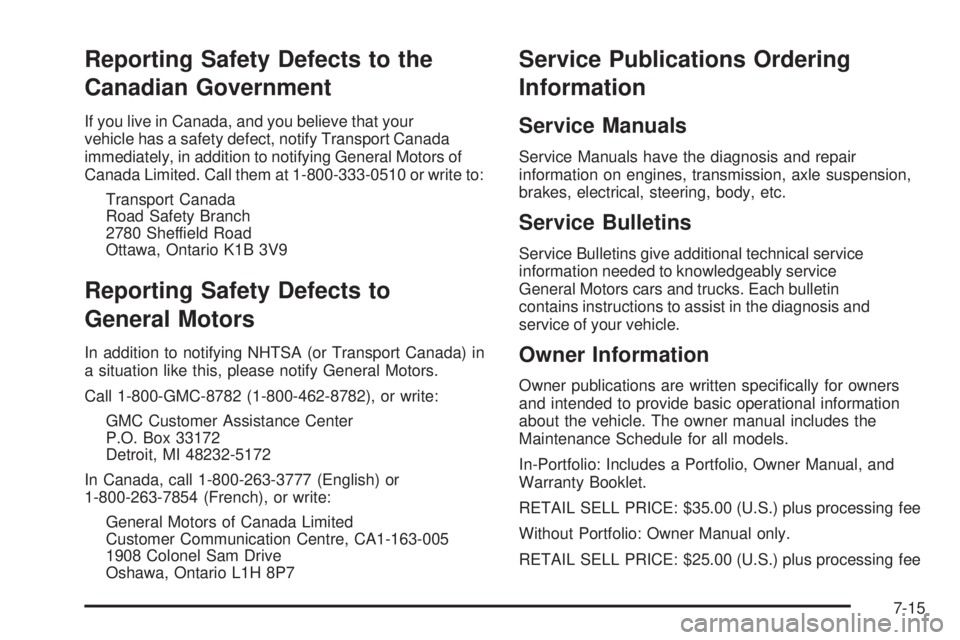
Reporting Safety Defects to the
Canadian Government
If you live in Canada, and you believe that your
vehicle has a safety defect, notify Transport Canada
immediately, in addition to notifying General Motors of
Canada Limited. Call them at 1-800-333-0510 or write to:
Transport Canada
Road Safety Branch
2780 Sheffield Road
Ottawa, Ontario K1B 3V9
Reporting Safety Defects to
General Motors
In addition to notifying NHTSA (or Transport Canada) in
a situation like this, please notify General Motors.
Call 1-800-GMC-8782 (1-800-462-8782), or write:
GMC Customer Assistance Center
P.O. Box 33172
Detroit, MI 48232-5172
In Canada, call 1-800-263-3777 (English) or
1-800-263-7854 (French), or write:
General Motors of Canada Limited
Customer Communication Centre, CA1-163-005
1908 Colonel Sam Drive
Oshawa, Ontario L1H 8P7
Service Publications Ordering
Information
Service Manuals
Service Manuals have the diagnosis and repair
information on engines, transmission, axle suspension,
brakes, electrical, steering, body, etc.
Service Bulletins
Service Bulletins give additional technical service
information needed to knowledgeably service
General Motors cars and trucks. Each bulletin
contains instructions to assist in the diagnosis and
service of your vehicle.
Owner Information
Owner publications are written speci�cally for owners
and intended to provide basic operational information
about the vehicle. The owner manual includes the
Maintenance Schedule for all models.
In-Portfolio: Includes a Portfolio, Owner Manual, and
Warranty Booklet.
RETAIL SELL PRICE: $35.00 (U.S.) plus processing fee
Without Portfolio: Owner Manual only.
RETAIL SELL PRICE: $25.00 (U.S.) plus processing fee
7-15
Page 560 of 576

Current and Past Model Order Forms
Technical Service Bulletins and Manuals are available
for current and past model GM vehicles. To request
an order form, specify year and model name of
the vehicle.
ORDER TOLL FREE: 1-800-551-4123
Monday-Friday 8:00 AM - 6:00 PM
Eastern Time
For Credit Card Orders Only
(VISA-MasterCard-Discover), visit Helm, Inc.
on the World Wide Web at: helminc.com
Or you can write to:
Helm, Incorporated
P.O. Box 07130
Detroit, MI 48207
Prices are subject to change without notice and without
incurring obligation. Allow ample time for delivery.
Note to Canadian Customers: All listed prices are
quoted in U.S. funds. Canadian residents are to make
checks payable in U.S. funds.
Vehicle Data Recording and
Privacy
Your GM vehicle has a number of sophisticated
computers that record information about the vehicle’s
performance and how it is driven. For example, your
vehicle uses computer modules to monitor and control
engine and transmission performance, to monitor the
conditions for airbag deployment and deploy airbags in
a crash and, if so equipped, to provide antilock braking
to help the driver control the vehicle. These modules
may store data to help your dealer/retailer technician
service your vehicle. Some modules may also store data
about how you operate the vehicle, such as rate of fuel
consumption or average speed. These modules may also
retain the owner’s personal preferences, such as radio
pre-sets, seat positions, and temperature settings.
7-16
Page 564 of 576
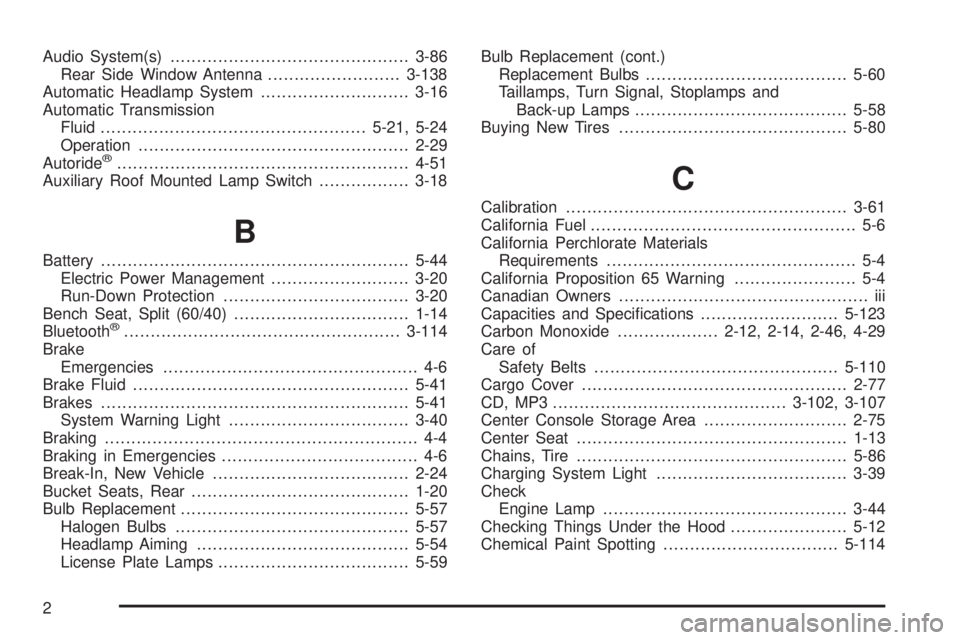
Audio System(s).............................................3-86
Rear Side Window Antenna.........................3-138
Automatic Headlamp System............................3-16
Automatic Transmission
Fluid..................................................5-21, 5-24
Operation...................................................2-29
Autoride
®.......................................................4-51
Auxiliary Roof Mounted Lamp Switch.................3-18
B
Battery..........................................................5-44
Electric Power Management..........................3-20
Run-Down Protection...................................3-20
Bench Seat, Split (60/40).................................1-14
Bluetooth
®....................................................3-114
Brake
Emergencies................................................ 4-6
Brake Fluid....................................................5-41
Brakes..........................................................5-41
System Warning Light..................................3-40
Braking........................................................... 4-4
Braking in Emergencies..................................... 4-6
Break-In, New Vehicle.....................................2-24
Bucket Seats, Rear.........................................1-20
Bulb Replacement...........................................5-57
Halogen Bulbs............................................5-57
Headlamp Aiming........................................5-54
License Plate Lamps....................................5-59Bulb Replacement (cont.)
Replacement Bulbs......................................5-60
Taillamps, Turn Signal, Stoplamps and
Back-up Lamps........................................5-58
Buying New Tires...........................................5-80
C
Calibration.....................................................3-61
California Fuel.................................................. 5-6
California Perchlorate Materials
Requirements............................................... 5-4
California Proposition 65 Warning....................... 5-4
Canadian Owners............................................... iii
Capacities and Speci�cations..........................5-123
Carbon Monoxide...................2-12, 2-14, 2-46, 4-29
Care of
Safety Belts..............................................5-110
Cargo Cover..................................................2-77
CD, MP3 ............................................3-102, 3-107
Center Console Storage Area...........................2-75
Center Seat...................................................1-13
Chains, Tire...................................................5-86
Charging System Light....................................3-39
Check
Engine Lamp..............................................3-44
Checking Things Under the Hood......................5-12
Chemical Paint Spotting.................................5-114
2
Page 567 of 576
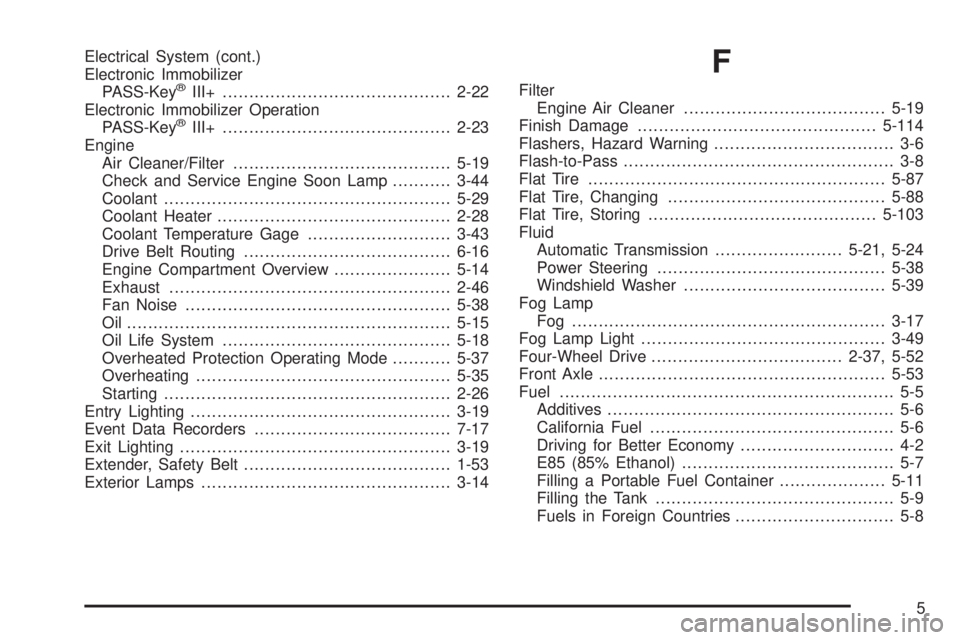
Electrical System (cont.)
Electronic Immobilizer
PASS-Key
®III+...........................................2-22
Electronic Immobilizer Operation
PASS-Key
®III+...........................................2-23
Engine
Air Cleaner/Filter.........................................5-19
Check and Service Engine Soon Lamp...........3-44
Coolant......................................................5-29
Coolant Heater............................................2-28
Coolant Temperature Gage...........................3-43
Drive Belt Routing.......................................6-16
Engine Compartment Overview......................5-14
Exhaust.....................................................2-46
Fan Noise..................................................5-38
Oil .............................................................5-15
Oil Life System...........................................5-18
Overheated Protection Operating Mode...........5-37
Overheating................................................5-35
Starting......................................................2-26
Entry Lighting.................................................3-19
Event Data Recorders.....................................7-17
Exit Lighting...................................................3-19
Extender, Safety Belt.......................................1-53
Exterior Lamps...............................................3-14
F
Filter
Engine Air Cleaner......................................5-19
Finish Damage.............................................5-114
Flashers, Hazard Warning.................................. 3-6
Flash-to-Pass................................................... 3-8
Flat Tire........................................................5-87
Flat Tire, Changing.........................................5-88
Flat Tire, Storing...........................................5-103
Fluid
Automatic Transmission........................5-21, 5-24
Power Steering...........................................5-38
Windshield Washer......................................5-39
Fog Lamp
Fog ...........................................................3-17
Fog Lamp Light..............................................3-49
Four-Wheel Drive....................................2-37, 5-52
Front Axle......................................................5-53
Fuel............................................................... 5-5
Additives...................................................... 5-6
California Fuel.............................................. 5-6
Driving for Better Economy............................. 4-2
E85 (85% Ethanol)........................................ 5-7
Filling a Portable Fuel Container....................5-11
Filling the Tank............................................. 5-9
Fuels in Foreign Countries.............................. 5-8
5
Page 575 of 576
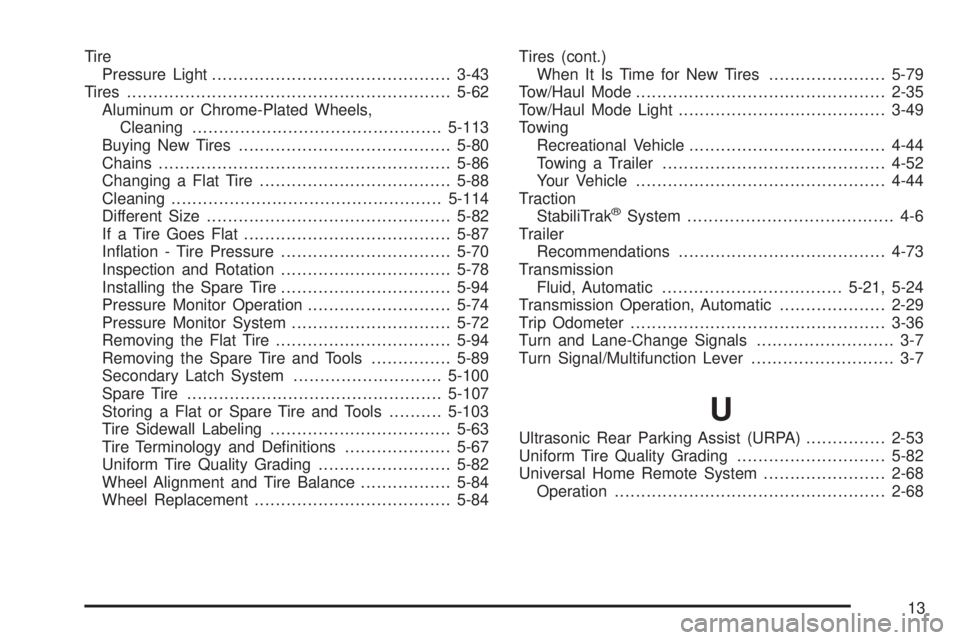
Tire
Pressure Light.............................................3-43
Tires.............................................................5-62
Aluminum or Chrome-Plated Wheels,
Cleaning...............................................5-113
Buying New Tires........................................5-80
Chains.......................................................5-86
Changing a Flat Tire....................................5-88
Cleaning...................................................5-114
Different Size..............................................5-82
If a Tire Goes Flat.......................................5-87
In�ation - Tire Pressure................................5-70
Inspection and Rotation................................5-78
Installing the Spare Tire................................5-94
Pressure Monitor Operation...........................5-74
Pressure Monitor System..............................5-72
Removing the Flat Tire.................................5-94
Removing the Spare Tire and Tools...............5-89
Secondary Latch System............................5-100
Spare Tire................................................5-107
Storing a Flat or Spare Tire and Tools..........5-103
Tire Sidewall Labeling..................................5-63
Tire Terminology and De�nitions....................5-67
Uniform Tire Quality Grading.........................5-82
Wheel Alignment and Tire Balance.................5-84
Wheel Replacement.....................................5-84Tires (cont.)
When It Is Time for New Tires......................5-79
Tow/Haul Mode ...............................................2-35
Tow/Haul Mode Light.......................................3-49
Towing
Recreational Vehicle.....................................4-44
Towing a Trailer..........................................4-52
Your Vehicle...............................................4-44
Traction
StabiliTrak
®System....................................... 4-6
Trailer
Recommendations.......................................4-73
Transmission
Fluid, Automatic..................................5-21, 5-24
Transmission Operation, Automatic....................2-29
Trip Odometer................................................3-36
Turn and Lane-Change Signals.......................... 3-7
Turn Signal/Multifunction Lever........................... 3-7
U
Ultrasonic Rear Parking Assist (URPA)...............2-53
Uniform Tire Quality Grading............................5-82
Universal Home Remote System.......................2-68
Operation...................................................2-68
13